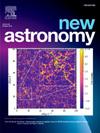强磁化变形白矮星的质量-半径关系
IF 2.1
4区 物理与天体物理
Q2 ASTRONOMY & ASTROPHYSICS
引用次数: 0
摘要
利用参数化γ-度量形式的恒星结构方程,研究了强磁化各向异性变形白矮星的质量和半径。建立了强量子化密度相关磁场中完全简并相对论性电子气体的态方程。考虑了磁场平行分量和垂直分量的流体和场压力各向异性。EoS的这种各向异性导致了恒星的轴对称变形。我们找到了变形的超级钱德拉塞卡超大质量白矮星的稳定解。在一定的中心电子数密度下,随着中心磁场强度的增加,质量首先从传统的钱德拉塞卡极限开始增加,达到最大值,然后随着中心磁场的进一步增加而减小。当中心磁场强度较低时,压力各向异性和产生的变形都很小,因此质量增加。在较高的中心磁场区,磁场压力各向异性明显增强。这导致了更大的球面对称变形,从而减少了恒星质量。我们还看到,随着中心磁场强度的增加,最大质量及其相应的赤道半径都减小。我们还注意到,随着磁场的增加,最大质量出现在较高的中心密度处。这些现象也会发生,因为压力各向异性较高而偏离了球对称。高磁场增加了恒星的致密性。本文章由计算机程序翻译,如有差异,请以英文原文为准。
Mass–radius relationship of strongly magnetized deformed white dwarfs
The masses and radii of strongly magnetized anisotropic deformed white dwarf stars are investigated using the stellar structure equations in the parameterized -metric formalism. The Equation of State (EoS) of a completely degenerate relativistic electron gas in strong quantizing density-dependent magnetic field is developed. The fluid and field pressure anisotropy among the parallel and perpendicular components to the magnetic field is taken into consideration. This anisotropy in the EoS causes axisymmetric deformation of the star. We found stable solutions of deformed super-Chandrasekhar ultramassive white dwarfs. At a fixed central electron number density, the mass first increases from the traditional Chandrasekhar limit with increase of central magnetic field strength, reaches a maximum and then decreases with further increase of central magnetic field. For lower central magnetic field strengths, both the pressure anisotropy and the resulting deformation are very less, and hence the mass increases. In the higher central magnetic field regime, the magnetic field pressure anisotropy becomes significantly strong. This leads to greater deformation from spherical symmetry and hence reduces the stellar mass. We also see that the maximum mass and its corresponding equatorial radius both decrease as central magnetic field strength increases. We also notice that the maximum mass occurs at higher central density as the magnetic field increases. These phenomena also occur because of the deviation from spherical symmetry due to higher pressure anisotropy. High magnetic field increases stellar compactness.
求助全文
通过发布文献求助,成功后即可免费获取论文全文。
去求助
来源期刊

New Astronomy
地学天文-天文与天体物理
CiteScore
4.00
自引率
10.00%
发文量
109
审稿时长
13.6 weeks
期刊介绍:
New Astronomy publishes articles in all fields of astronomy and astrophysics, with a particular focus on computational astronomy: mathematical and astronomy techniques and methodology, simulations, modelling and numerical results and computational techniques in instrumentation.
New Astronomy includes full length research articles and review articles. The journal covers solar, stellar, galactic and extragalactic astronomy and astrophysics. It reports on original research in all wavelength bands, ranging from radio to gamma-ray.
 求助内容:
求助内容: 应助结果提醒方式:
应助结果提醒方式:


